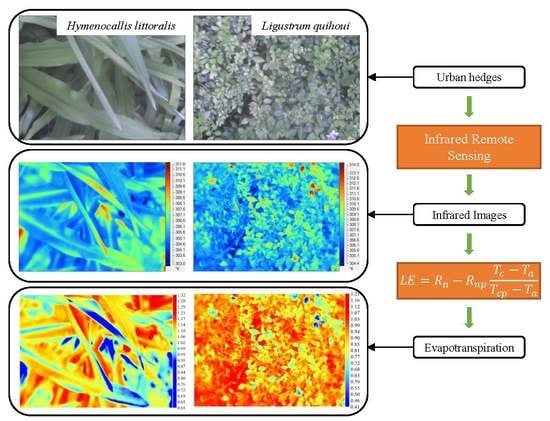Quantifying the Evapotranspiration Rate and Its Cooling Effects of Urban Hedges Based on Three-Temperature Model and Infrared Remote Sensing
Abstract
:1. Introduction
2. Material and Methods
2.1. Study Site
2.2. Three-Temperature Model
2.3. Field Experiments
2.4. Verification Experiment
3. Results
3.1. Method Verification
3.2. Characteristics of Meteorological Conditions
3.3. ET Characteristics of Urban Hedges
3.3.1. Surface Temperatures of the Urban Hedges
3.3.2. ET Rates of the Urban Hedges
3.3.3. The LE/Rn of the Urban Hedges
3.4. Cooling Effects of Urban Hedges
3.4.1. Cooling Effects on Air Temperature of the Urban Hedges
3.4.2. Cooling Effects of the Urban Hedges on Surface Temperature
4. Discussion
4.1. The ET Characteristics of Urban Hedges
4.2. Cooling Effect of the Urban Hedges
4.3. Applicability of the ‘3T + IR’ Method for the ET Estimation of Urban Hedges
5. Conclusions
Author Contributions
Funding
Acknowledgments
Conflicts of Interest
References
- Tan, J.; Zheng, Y.; Tang, X.; Guo, C.; Li, L.; Song, G.; Zhen, X.; Yuan, D.; Kalkstein, A.J.; Li, F. The urban heat island and its impact on heat waves and human health in Shanghai. Int. J. Biometeorol. 2010, 54, 75–84. [Google Scholar] [CrossRef]
- Gaffin, S.R.; Rosenzweig, C.; Khanbilvardi, R.; Parshall, L.; Mahani, S.; Glickman, H.; Goldberg, R.; Blake, R.; Slosberg, R.B.; Hillel, D. Variations in New York city’s urban heat island strength over time and space. Theor. Appl. Climatol. 2008, 94, 1–11. [Google Scholar] [CrossRef]
- Ren, G.; Zhou, Y.; Chu, Z.; Zhou, J.; Zhang, A.; Guo, J.; Liu, X. Urbanization Effects on Observed Surface Air Temperature Trends in North China. J. Clim. 2008, 21, 1333–1348. [Google Scholar] [CrossRef]
- Peng, S.; Piao, S.; Ciais, P.; Friedlingstein, P.; Ottle, C.; Bréon, F.M.; Nan, H.; Zhou, L.; Myneni, R.B. Surface urban heat island across 419 global big cities. Environ. Sci. Technol. 2012, 46, 696–703. [Google Scholar] [CrossRef]
- Lin, W.; Wu, T.; Zhang, C.; Yu, T. Carbon savings resulting from the cooling effect of green areas: A case study in Beijing. Environ. Pollut. 2011, 159, 2148–2154. [Google Scholar] [CrossRef]
- Gobakis, K.; Kolokotsa, D.; Synnefa, A.; Saliari, M.; Giannopoulou, K.; Santamouris, M. Development of a model for urban heat island prediction using neural network techniques. Sustain. Cities Soc. 2011, 1, 104–115. [Google Scholar] [CrossRef]
- Gosling, S.N.; Lowe, J.A.; Mcgregor, G.R.; Pelling, M.; Malamud, B.D. Associations between elevated atmospheric temperature and human mortality: A critical review of the literature. Clim. Chang. 2009, 92, 299–341. [Google Scholar] [CrossRef]
- Kinney, P.L. Climate change, air quality, and human health. Am. J. Prev. Med. 2008, 35, 459–467. [Google Scholar] [CrossRef]
- Merte, S. Estimating heat wave-related mortality in Europe using singular spectrum analysis. Clim. Chang. 2017, 142, 321–330. [Google Scholar] [CrossRef]
- Santamouris, M. Cooling the cities—A review of reflective and green roof mitigation technologies to fight heat island and improve comfort in urban environments. Sol. Energy 2014, 103, 682–703. [Google Scholar] [CrossRef]
- Ketterer, C.; Matzarakis, A. Human-biometeorological assessment of heat stress reduction by replanning measures in Stuttgart, Germany. Landsc. Urban Plan. 2014, 122, 78–88. [Google Scholar] [CrossRef]
- Akbari, H.; Pomerantz, M.; Taha, H. Cool surfaces and shade trees to reduce energy use and improve air quality in urban areas. Sol. Energy 2001, 70, 295–310. [Google Scholar] [CrossRef]
- Xu, C.Y.; Chen, D. Comparison of seven models for estimation of evapotranspiration and groundwater recharge using lysimeter measurement data in Germany. Hydrol. Process. 2010, 19, 3717–3734. [Google Scholar] [CrossRef]
- Takebayashi, H.; Moriyama, M. Study on the urban heat island mitigation effect achieved by converting to grass-covered parking. Sol. Energy 2009, 83, 1211–1223. [Google Scholar] [CrossRef] [Green Version]
- Nastran, M.; Kobal, M.; Eler, K. Urban Heat Islands in Relation to Green Land Use in European Cities. Urban For. Urban Green. 2018, in press. [Google Scholar] [CrossRef]
- Imran, H.M.; Kala, J.; Ng, A.W.M.; Muthukumaran, S. Effectiveness of green and cool roofs in mitigating urban heat island effects during a heatwave event in the city of Melbourne in southeast Australia. J. Clean Prod. 2018, 197, 393–405. [Google Scholar] [CrossRef]
- Mariani, L.; Parisi, S.G.; Cola, G.; Lafortezza, R.; Colangelo, G.; Sanesi, G. Climatological analysis of the mitigating effect of vegetation on the urban heat island of Milan, Italy. Sci. Total Environ. 2016, 569–570, 762–773. [Google Scholar] [CrossRef]
- Zheng, S.; Zhao, L.; Li, Q. Numerical simulation of the impact of different vegetation species on the outdoor thermal environment. Urban For. Urban Green. 2016, 18, 138–150. [Google Scholar] [CrossRef]
- Akbari, H.; Dan, M.K.; Bretz, S.E.; Hanford, J.W. Peak power and cooling energy savings of shade trees. Energy Build. 1997, 25, 139–148. [Google Scholar] [CrossRef]
- Ballinas, M.; Barradas, V.L. The Urban Tree as a Tool to Mitigate the Urban Heat Island in Mexico City: A Simple Phenomenological Model. J. Environ. Qual. 2016, 45, 157–166. [Google Scholar] [CrossRef]
- Hamada, S.; Ohta, T. Seasonal variations in the cooling effect of urban green areas on surrounding urban areas. Urban For. Urban Green. 2010, 9, 15–24. [Google Scholar] [CrossRef]
- Feyisa, G.L.; Dons, K.; Meilby, H. Efficiency of parks in mitigating urban heat island effect: An example from Addis Ababa. Landsc. Urban Plan. 2014, 123, 87–95. [Google Scholar] [CrossRef]
- Doick, K.J.; Peace, A.; Hutchings, T.R. The role of one large greenspace in mitigating London’s nocturnal urban heat island. Sci. Total Environ. 2014, 493, 662–671. [Google Scholar] [CrossRef]
- Wong, N.H.; Jusuf, S.K.; Win, A.A.L.; Thu, H.K.; Negara, T.S.; Wu, X. Environmental study of the impact of greenery in an institutional campus in the tropics. Build. Environ. 2007, 42, 2949–2970. [Google Scholar] [CrossRef]
- Weng, Q.; Yang, S. Managing the adverse thermal effects of urban development in a densely populated Chinese city. J. Environ. Manag. 2004, 70, 145–156. [Google Scholar] [CrossRef]
- Dimoudi, A.; Nikolopoulou, M. Vegetation in the urban environment: Microclimatic analysis and benefits. Energy Build. 2003, 35, 69–76. [Google Scholar] [CrossRef]
- Scott, K.I.; Simpson, J.R.; Mcpherson, E.G. Effects of tree cover on parking lot microclimate and vehicle emissions. J. Arboric. 1999, 25, 129–142. [Google Scholar]
- Berthier, E.; Dupont, S.; Mestayer, P.G.; Andrieu, H. Comparison of two evapotranspiration schemes on a sub-urban site. J. Hydrol. 2006, 328, 635–646. [Google Scholar] [CrossRef]
- Lazzarin, R.M.; Castellotti, F.; Busato, F. Experimental measurements and numerical modelling of a green roof. Energy Build. 2005, 37, 1260–1267. [Google Scholar] [CrossRef]
- Qiu, G.; Tan, S.; Wang, Y.; Yu, X.; Yan, C. Characteristics of Evapotranspiration of Urban Lawns in a Sub-Tropical Megacity and Its Measurement by the ‘Three Temperature Model + Infrared Remote Sensing’ Method. Remote Sens. 2017, 9, 502. [Google Scholar] [Green Version]
- Nouri, H.; Glenn, E.; Beecham, S.; Chavoshi Boroujeni, S.; Sutton, P.; Alaghmand, S.; Noori, B.; Nagler, P. Comparing Three Approaches of Evapotranspiration Estimation in Mixed Urban Vegetation: Field-Based, Remote Sensing-Based and Observational-Based Methods. Remote Sens. 2016, 8, 492. [Google Scholar] [CrossRef]
- Pataki, D.E.; Mccarthy, H.R.; Litvak, E.; Pincetl, S. Transpiration of urban forests in the Los Angeles metropolitan area. Ecol. Appl. 2011, 21, 661–677. [Google Scholar] [CrossRef]
- DiGiovanni, K.; Montalto, F.; Gaffin, S.; Rosenzweig, C. Evaluation of Physically and Empirically Based Models for the Estimation of Green Roof Evapotranspiration. J. Hydrol. Eng. 2010, 18, 99–107. [Google Scholar] [CrossRef]
- Qiu, G.Y.; Momii, K.; Yano, T. Estimation of Plant Transpiration by Imitation Leaf Temperature: Theoretical consideration and field verification (I). Trans. Jpn. Soc. Irrig. Drain. Rural Eng. 1996, 64, 401–410. [Google Scholar]
- Qiu, G.Y.; Yano, T.; Momii, K. Estimation of Plant Transpiration by Imitation Leaf Temperature: Application of imitation leaf temperature for detection of crop water stress (II). Trans. Jpn. Soc. Irrig. Drain. Rural Eng. 1996, 64, 767–773. [Google Scholar]
- Wang, Y.Q.; Xiong, Y.J.; Qiu, G.Y.; Zhang, Q.T. Is scale really a challenge in evapotranspiration estimation? A multi-scale study in the Heihe oasis using thermal remote sensing and the three-temperature model. Agric. For. Meteorol. 2016, 230–231, 128–141. [Google Scholar] [CrossRef]
- Tian, F.; Qiu, G.Y.; Lü, Y.H.; Yang, Y.H.; Xiong, Y. Use of high-resolution thermal infrared remote sensing and “three-temperature model” for transpiration monitoring in arid inland river catchment. J. Hydrol. 2014, 515, 307–315. [Google Scholar] [CrossRef]
- Xiong, Y.J.; Qiu, G.Y. Simplifying the revised three-temperature model for remotely estimating regional evapotranspiration and its application to a semi-arid steppe. Int. J. Remote Sens. 2014, 35, 2003–2027. [Google Scholar]
- Xiong, Y.J.; Qiu, G.Y. Estimation of evapotranspiration using remotely sensed land surface temperature and the revised three-temperature model. Int. J. Remote Sens. 2011, 32, 5853–5874. [Google Scholar] [CrossRef]
- Qiu, G.Y.; Benasher, J. Experimental determination of soil evaporation stages with soil surface temperature. Soil Sci. Soc. Am. J. 2010, 74, 13–22. [Google Scholar] [CrossRef]
- Qiu, G.Y.; Zhao, M. Remotely monitoring evaporation rate and soil water status using thermal imaging and “three-temperatures model (3T model)” under field-scale conditions. J. Environ. Monit. 2010, 12, 716–723. [Google Scholar] [CrossRef]
- Qiu, G.Y.; Li, C.; Yan, C. Characteristics of soil evaporation, plant transpiration and water budget of Nitraria dune in the arid Northwest China. Agric. For. Meteorol. 2015, 203, 107–117. [Google Scholar] [CrossRef]
- Qiu, G.Y.; Miyamoto, K.; Sase, S.; Okushima, L. Detection of crop transpiration and water stress by temperature-related approach under field and greenhouse conditions. JARQ Jpn. Agric. Res. Q. 2000, 34, 29–37. [Google Scholar]
- Cao, L.; Zhang, Y.; Lu, H.; Yuan, J.; Zhu, Y.; Liang, Y. Grass hedge effects on controlling soil loss from concentrated flow: A case study in the red soil region of China. Soil Tillage Res. 2015, 148, 97–105. [Google Scholar] [CrossRef]
- Forman, R.T.T.; Baudry, J. Hedgerows and hedgerow networks in landscape ecology. Environ. Manag. 1984, 8, 495–510. [Google Scholar] [CrossRef]
- Gosling, L.; Sparks, T.H.; Araya, Y.; Harvey, M.; Ansine, J. Differences between urban and rural hedges in England revealed by a citizen science project. BMC Ecol. 2016, 16 (Suppl. 1), 45–55. [Google Scholar] [CrossRef]
- Gromke, C.; Jamarkattel, N.; Ruck, B. Influence of roadside hedgerows on air quality in urban street canyons. Atmos. Environ. 2016, 139, 75–86. [Google Scholar] [CrossRef]
- Yan, C.; Qiu, G.Y. The three-temperature model to estimate evapotranspiration and its partitioning at multiple scales: A review. Trans. ASABE 2016, 59, 661–670. [Google Scholar]
- Jensen, M.E.; Burman, R.D.; Allen, R.G. Evapotranspiration and irrigation water requirements. In Manuals and Reports on Engineering Practice No. 70; American Society of Civil Engineers: New York, NY, USA, 1990; pp. 25–41. [Google Scholar]
- Weiss, A. An Experimental Study of Net Radiation, Its Components and Prediction. Agron. J. 1982, 74, 871–874. [Google Scholar] [CrossRef]
- Burman, R.D.; Cuenca, R.H.; Weiss, A. Techniques for estimating irrigation water requirements. In Advances in Irrigation; Elsevier: New York, NY, USA, 1983; Volume 2, pp. 335–394. [Google Scholar]
- Hatfield, J.L.; Reginato, R.J.; Idso, S.B. Comparison of long-wave radiation calculation methods over the United States. Water Resour. Res. 1983, 19, 285–288. [Google Scholar] [CrossRef]
- Bowen, I.S. The Ratio of Heat Losses by Conduction and by Evaporation from any Water Surface. Phys Rev. 1926, 27, 779–787. [Google Scholar] [CrossRef] [Green Version]
- Meteorological Bureau of Shenzhen Municipality. Available online: http://www.szmb.gov.cn/qixiangfuwu/qihoufuwu/qihouguanceyupinggu/qihougaikuang/201711/t20171109_9584854.htm (accessed on 5 December 2018).
- Anjos, M.; Lopes, A. Urban Heat Island and Park Cool Island Intensities in the Coastal City of Aracaju, North-Eastern Brazil. Sustainability 2017, 9, 1379. [Google Scholar] [CrossRef]
- Shiflett, S.A.; Liang, L.L.; Crum, S.M.; Feyisa, G.L.; Wang, J.; Jenerette, G.D. Variation in the urban vegetation, surface temperature, air temperature nexus. Sci. Total Environ. 2017, 579, 495–505. [Google Scholar] [CrossRef]
- Park, J.; Kim, J.H.; Dong, K.L.; Park, C.Y.; Jeong, S.G. The influence of small green space type and structure at the street level on urban heat island mitigation. Urban For. Urban Green. 2016, 21, 203–212. [Google Scholar] [CrossRef]
- Zhu, L.W.; Zhao, P. Temporal Variation in Sap-Flux-Scaled Transpiration and Cooling Effect of a Subtropical Schima superba Plantation in the Urban Area of Guangzhou. J. Integr. Agric. 2013, 12, 1350–1356. [Google Scholar] [CrossRef]
- Mohan, M.; Kandya, A. Impact of urbanization and land-use/land-cover change on diurnal temperature range: A case study of tropical urban airshed of India using remote sensing data. Sci. Total Environ. 2015, 506–507, 453–465. [Google Scholar] [CrossRef]
- Zhang, X.J.; De-Ming, L.I.; Zhai, K.R. Study on Light and Water Utilization Characteristics of Several Ground Cover Plants. North Hortic. 2010, 12, 75–78, (In Chinese with English Abstract). [Google Scholar]
- Zhu, Y.Q.; Yang, B.S.; Ya-Xin, Y.U.; Jin, X.L. Comparison of temperature decrease and humidity increase effect of familiar shrub species in Changsha City. Guangdong Agric. Sci. 2013, 9, 42–45, (In Chinese with English Abstract). [Google Scholar]
- Liu, Y.; Peng, J.; Wang, Y. Diversification of Land Surface Temperature Change under Urban Landscape Renewal: A Case Study in the Main City of Shenzhen, China. Remote Sens. 2017, 9, 919. [Google Scholar] [CrossRef]
- Saadatian, O.; Sopian, K.; Salleh, E.; Lim, C.H.; Riffat, S.; Saadatian, E.; Toudeshki, A.; Sulaiman, M.Y. A review of energy aspects of green roofs. Renew. Sustain. Energy Rev. 2013, 23, 155–168. [Google Scholar] [CrossRef]
- Qiu, G.Y.; Zou, Z.; Li, X.; Li, H.; Guo, Q.; Yan, C.; Tan, S. Experimental studies on the effects of green space and evapotranspiration on urban heat island in a subtropical megacity in China. Habitat Int. 2017, 68, 30–42. [Google Scholar] [CrossRef]
- Zhang, E.J.; Zhang, J.J.; Zhao, X.Y.; Zhang, X.L. Study on urban heat island effect in Shenzhen. J. Nat. Disasters 2008, 17, 19–24, (In Chinese with English Abstract). [Google Scholar]
- Schmidt, M.; Tu-Berlin, D.I. The interaction between water and energy of greened roofs. In Proceedings of the World Green Roof Congress, Basel, Switzerland, 15–16 September 2005. [Google Scholar]
- Grimmond, C.S.B.; Salmond, J.A.; Oke, T.R.; Offerle, B.; Lemonsu, A. Flux and turbulence measurements at a densely built-up site in Marseille: Heat, mass (water and carbon dioxide), and momentum. J. Geophys. Res. 2004, 109, D24101. [Google Scholar] [CrossRef]
- Balogun, A.A.; Adegoke, J.O.; Vezhapparambu, S.; Mauder, M.; Mcfadden, J.P.; Gallo, K. Surface Energy Balance Measurements Above an Exurban Residential Neighbourhood of Kansas City, Missouri. Bound.-Layer Meteor. 2009, 133, 299–321. [Google Scholar] [CrossRef] [Green Version]
- Moriwaki, R.; Kanda, M. Seasonal and diurnal fluxes of radiation, heat, water vapor and carbon dioxide over a suburban area. J. Appl. Meteorol. 2004, 43, 1700–1710. [Google Scholar] [CrossRef]
- Blok, D.; Schaepmanstrub, G.; Bartholomeus, H.; Heijmans, M.M.P.D.; Maximov, T.C.; Berendse, F. The response of Arctic vegetation to the summer climate: Relation between shrub cover, NDVI, surface albedo and temperature. Environ. Res. Lett. 2011, 6, 035502. [Google Scholar] [CrossRef]
- Prado, R.T.A.; Ferreira, F.L. Measurement of albedo and analysis of its influence the surface temperature of building roof materials. Energy Build. 2005, 37, 295–300. [Google Scholar] [CrossRef]
- Crawford, A.J.; Mclachlan, D.H.; Hetherington, A.M.; Franklin, K.A. High temperature exposure increases plant cooling capacity. Curr. Biol. 2012, 22, R396–R397. [Google Scholar] [CrossRef] [Green Version]
- Xie, M.; Wang, Y.; Meichen, F.U.; Zhang, D. Pattern Dynamics of Thermal-environment Effect During Urbanization: A Case Study in Shenzhen City, China. Chin. Geogr. Sci. 2013, 23, 101–112, (In Chinese with English Abstract). [Google Scholar] [CrossRef]
- Leuzinger, S.; Vogt, R.; Körner, C. Tree surface temperature in an urban environment. Agric. For. Meteorol. 2010, 150, 56–62. [Google Scholar] [CrossRef]
- Chen, Z.; Gong, C.; Wu, J.; Yu, S. The influence of socioeconomic and topographic factors on nocturnal urban heat islands: A case study in Shenzhen, China. Int. J. Remote Sens. 2012, 33, 3834–3849. [Google Scholar] [CrossRef]
- Wong, N.H.; Chen, Y.; Ong, C.L.; Sia, A. Investigation of thermal benefits of rooftop garden in the tropical environment. Build. Environ. 2003, 38, 261–270. [Google Scholar] [CrossRef]
- Yang, Y.; Ren, R. On the Contrasting Decadal Changes of Diurnal Surface Temperature Range between the Tibetan Plateau and Southeastern China during the 1980s–2000s. Adv. Atmos. Sci. 2017, 34, 181–198. [Google Scholar] [CrossRef]
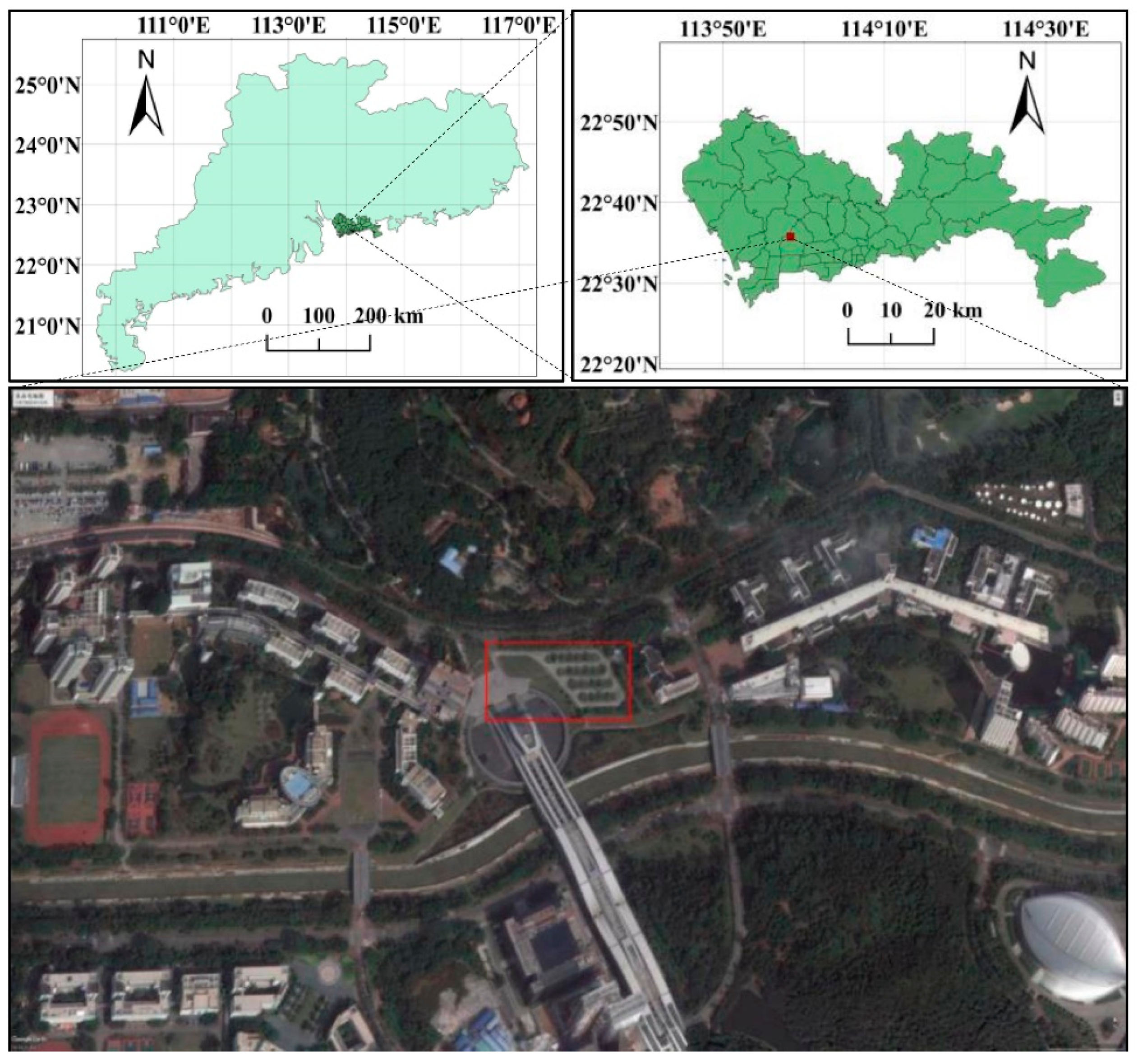

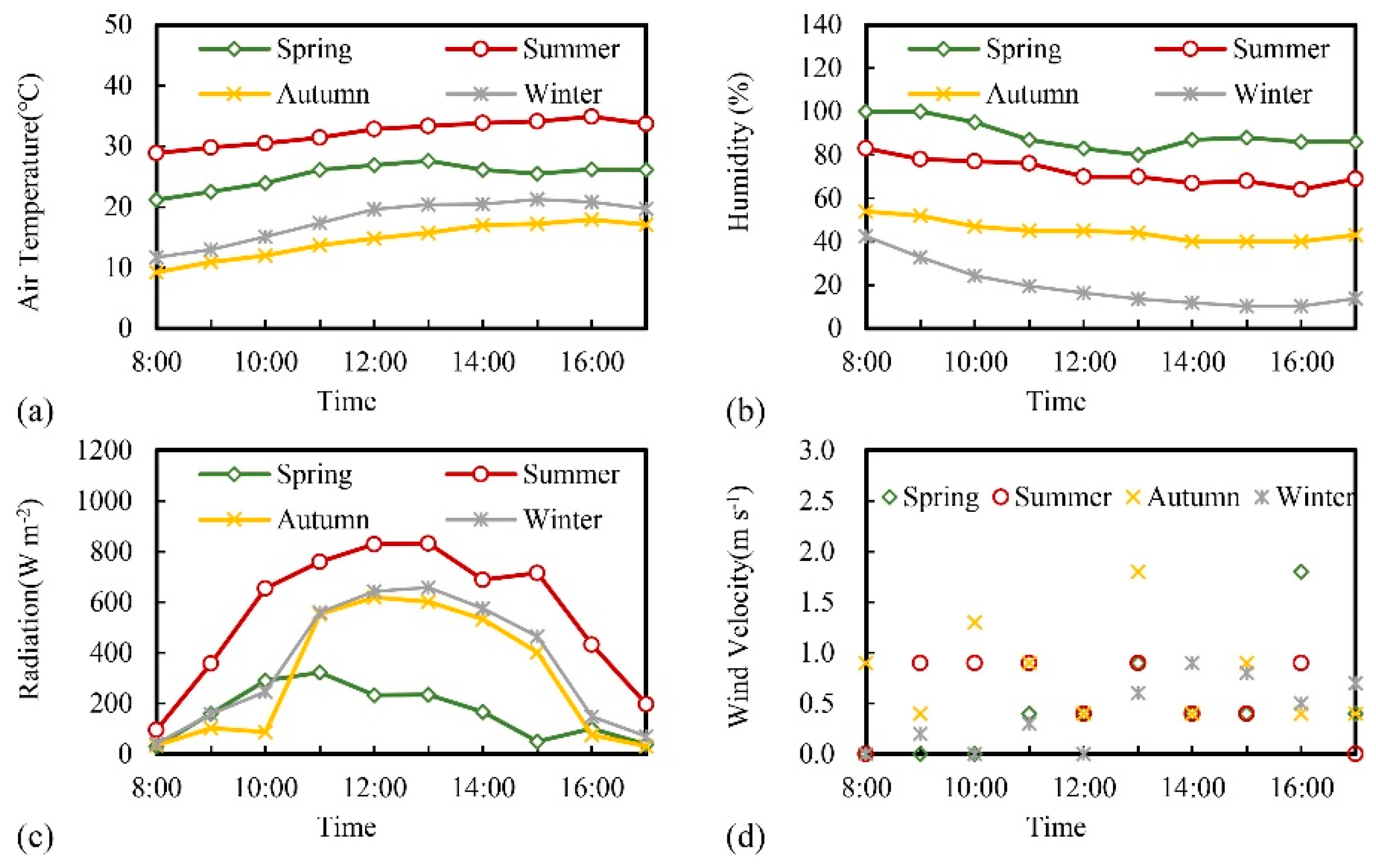



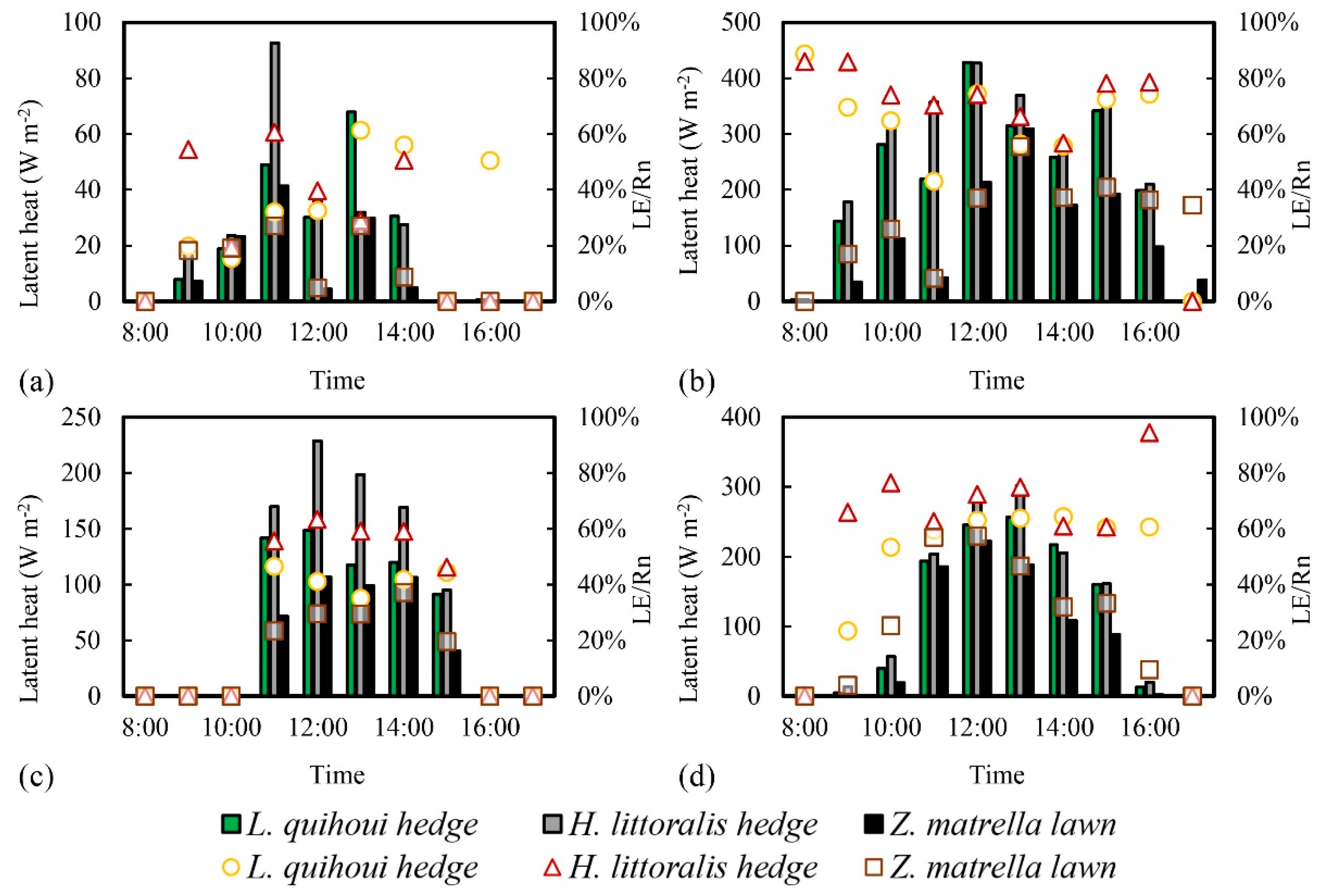

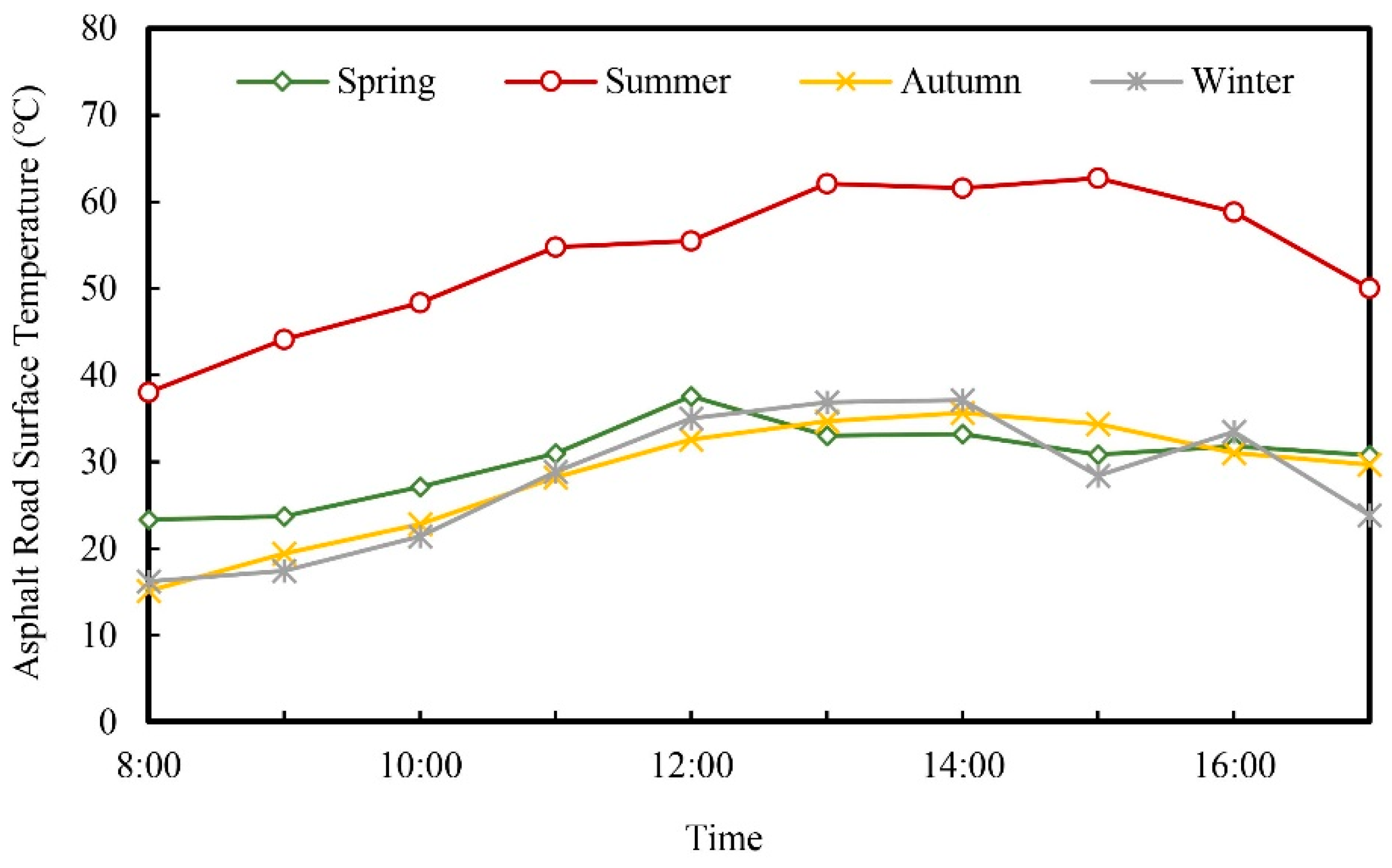
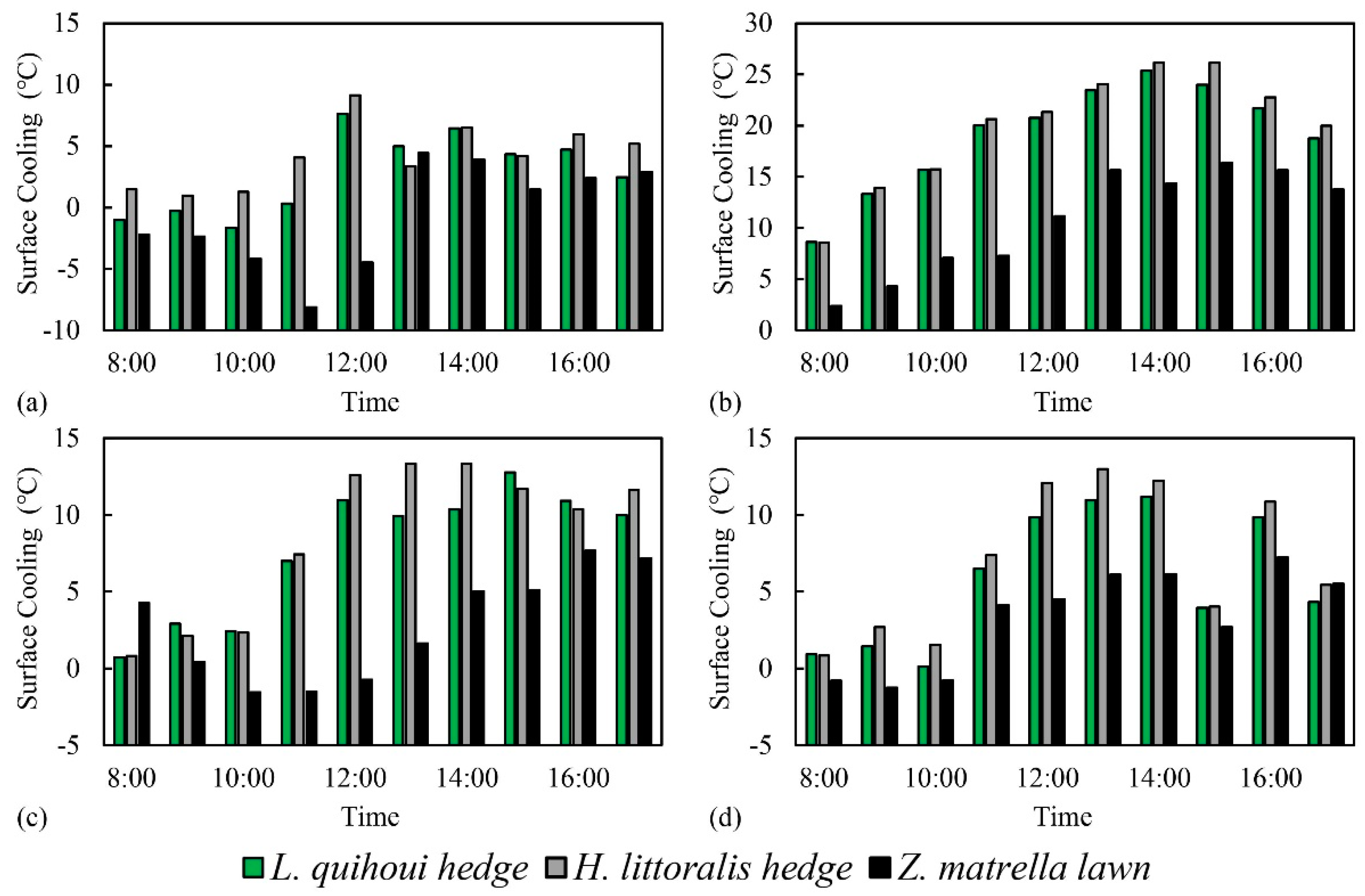
| Parameter | Sensor Type | Measuring Height(m) | Sensor Resolution |
|---|---|---|---|
| Humidity and Air Temperature | 225-050YA, Novalynx, Grass Valley, CA, USA | 2.0; 1.5 | ±3%, ±0.6 °C |
| Wind Velocity | 200-WS-02, Novalynx, Grass Valley, CA, USA | 2.0 | ±0.2 m s−1 |
| Solar Radiation | PYP-PA, Apogee, Santa Monica, CA, USA | 2.0 | 10–40 μV/W/m2 |
| Net Radiation | 240-100, Novalynx, Grass Valley, CA, USA | 2.0 | <4% |
| Soil Heat Flux | HFP01, Hukseflux, Center Moriches, NY, USA | −0.05; −0.02 | 50 μV/W/m2 |
| Seasons | H. littoralis Hedge | L. quihoui Hedge | Z. matrella Lawn |
|---|---|---|---|
| Spring | 0.04 | 0.03 | 0.02 |
| Summer | 0.38 | 0.33 | 0.18 |
| Autumn | 0.13 | 0.09 | 0.06 |
| Winter | 0.18 | 0.17 | 0.12 |
| Seasons | H. littoralis Hedge | L. quihoui Hedge | Z. matrella Lawn |
|---|---|---|---|
| Spring | 37.27% | 35.72% | 28.23% |
| Summer | 68.44% | 60.81% | 39.52% |
| Autumn | 56.10% | 41.45% | 34.06% |
| Winter | 65.71% | 61.58% | 47.28% |
| Underlying Surface | Spring | Summer | Autumn | Winter |
|---|---|---|---|---|
| Asphalt pavement | 4.18 | 7.90 | 6.65 | 7.43 |
| H. littoralis hedge | 2.22 | 2.85 | 2.43 | 3.46 |
| L. quihoui hedge | 2.06 | 3.14 | 3.14 | 3.69 |
| Z. matrella lawn | 5.16 | 4.19 | 6.71 | 5.04 |
© 2019 by the authors. Licensee MDPI, Basel, Switzerland. This article is an open access article distributed under the terms and conditions of the Creative Commons Attribution (CC BY) license (http://creativecommons.org/licenses/by/4.0/).
Share and Cite
Zou, Z.; Yang, Y.; Qiu, G.Y. Quantifying the Evapotranspiration Rate and Its Cooling Effects of Urban Hedges Based on Three-Temperature Model and Infrared Remote Sensing. Remote Sens. 2019, 11, 202. https://doi.org/10.3390/rs11020202
Zou Z, Yang Y, Qiu GY. Quantifying the Evapotranspiration Rate and Its Cooling Effects of Urban Hedges Based on Three-Temperature Model and Infrared Remote Sensing. Remote Sensing. 2019; 11(2):202. https://doi.org/10.3390/rs11020202
Chicago/Turabian StyleZou, Zhendong, Yajun Yang, and Guo Yu Qiu. 2019. "Quantifying the Evapotranspiration Rate and Its Cooling Effects of Urban Hedges Based on Three-Temperature Model and Infrared Remote Sensing" Remote Sensing 11, no. 2: 202. https://doi.org/10.3390/rs11020202




